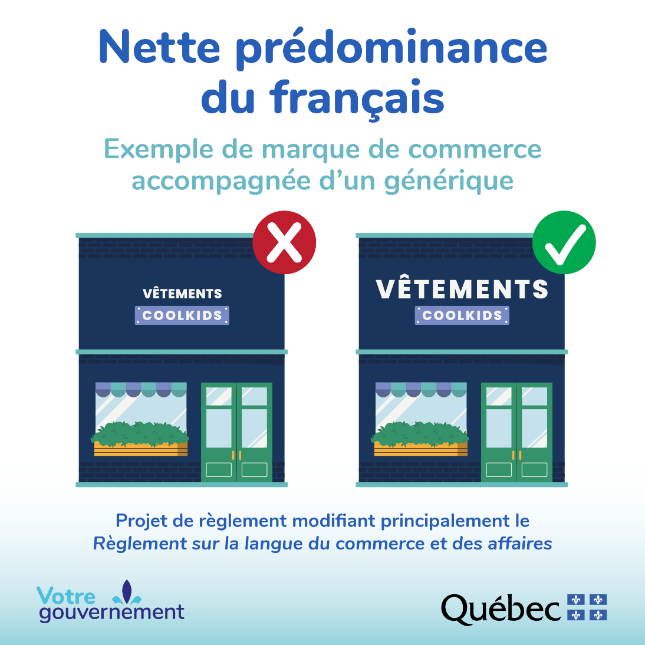This article is part of a three-part-series on the final version of the regulation respecting the language of commerce and business in Québec.
On June 26, the Québec government published the final version of the Regulation to amend mainly the Regulation respecting the Language of Commerce and Business (the Regulation), under its authority to do so as per the Charter of the French Language (the Charter).
The new Regulation is set to come into force on June 1, 2025, with the exception of its provisions related to contracts of adhesion, which have already come into effect.
The Regulation will also enact new rules related to the use of French, and on the use of languages other than French, in the context of products, contracts and public signs, posters and commercial advertising.
This Bulletin discusses more specifically how the Regulation impact specifically the rules governing the use of French in the context of contracts.
Public signs, posters and commercial advertising
Under the Charter, the general rule is that public signs and posters as well as commercial advertising displayed in the province of Québec must be in French. While they may also be both in French and another language, the French version of the sign, poster or commercial advertising must be “markedly predominant” relative to text shown in another language.
Expanded definition of "recognized trademark"?
Whereas, with respect to public signs, posters and commercial advertising, the draft regulation did not provide that registered trademarks were to include pending applications, the Regulation now replaces the section referencing pending applications and/or registrations and reintroduces the concept of a “recognized trademark". As in the case of markings on products, as long as no French-language version of a "recognized trademark" appears on the trademarks Register, a "recognized trademark" (seemingly including unregistered trademarks as well as trademarks that are the subject of pending applications or registrations) may be displayed, even partially, in a language other than French on public signs, posters and commercial advertising. How the OQLF will ultimately decide to apply the Regulation and the Charter remains to be seen.
Markedly predominant – French will need to be twice as large or twice the space
The Regulation will repeal the Regulation defining the scope of the expression “markedly predominant” for the purposes of the Charter of the French language. As of June 1, 2025, for all public signs, posters and commercial advertising displaying content in French and another language, French will be deemed to be markedly predominant if the text in French has a much greater visual impact than the text in another language. To comply with this requirement, in the same visual field, the space allotted to French will need to be:
- at least twice as large as the text in another language; and
- the legibility and permanent visibility of the French text will need to be equivalent to those of the text in another language.
“Same visual field” refers to an overall view where all the components of the public signs and posters and commercial advertising are visible and legible at the same time without having to move.
Noteworthy: The Regulation maintains the requirement initially found in the draft regulation which requires French to be “at least twice as large” as the text in another language. To illustrate the impact of the Regulation on public signs, posters and commercial advertising, an example published by the government of Québec in respect of this requirement is reproduced below:

While this may require many businesses to review and change their public signage, posters or commercial advertising, it must be remembered that the marked predominance of French must be assessed from the same visual field. As a result, the display of a "recognized trademark" in a language other than French where such "recognized trademark"
appears larger than the text displayed in French will be permitted provided that i) in the same visual field, the space allotted to French is at least twice the space allotted to text in another language and ii) the legibility and permanent visibility of both texts is equivalent, as shown in the following examples:


In the compliant example on the left, while the English trademark “COSTLESS” appears larger than the French word “Vêtements” on the storefront sign, the sign includes additional French words, such that when considered in its entirety, French words appearing on the sign, occupy twice as much space as the English trademark COSTLESS.
In the compliant example on the right, the English trademark “COOLKIDS” is larger than the French word “Vêtements” but the façade of the building also shows a slogan in French. Taken together, the space allotted to French is twice as large as the space allotted to the English trademark, despite the French text being shown in smaller characters.
The Regulation will also enact rules with respect to dynamic signage. When French and another language are displayed in alternation, French will be deemed to have a much greater visual impact than the text in another language when the French text is visible “at least twice as long” as the text in another language.
Addition of generic term, description or slogan
Where a trademark or a business’s name in a language other than French is displayed on public signage (storefronts) or posters which are visible from outside premises, the Regulation provides that, in order to comply with the “markedly predominant” requirement, a French generic term, a French description of the goods/services or a French slogan will need to be added to the trademark or business name appearing in a language other than French. This generic term, description or slogan will not necessarily need to be twice as visible as the trademark and will be taken into consideration in determining whether or not French has a much greater visual impact than the text in a language other than French.
BLG’s Intellectual Property Group has knowledge and experience in all matters related to Québec language laws and public signs, posters and commercial advertising. If you have any questions related to the Regulation respecting the language of commerce and business, please reach out to any of the authors or key contacts below.




